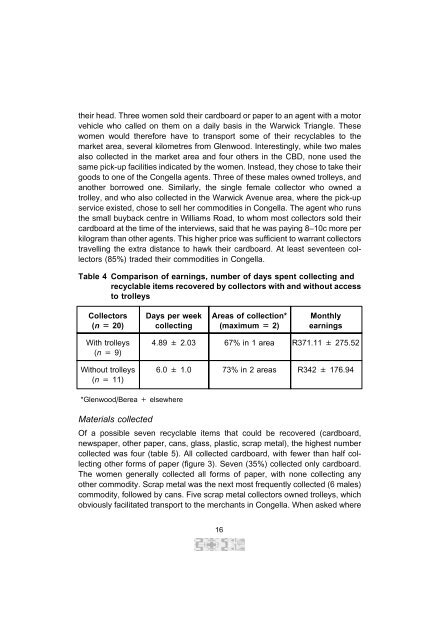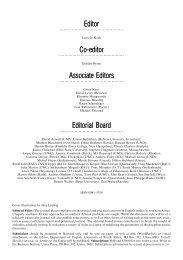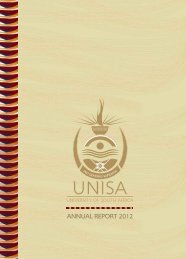AFRICANUS Vol 30 No 2 ISSN 0304-615X - University of South Africa
AFRICANUS Vol 30 No 2 ISSN 0304-615X - University of South Africa
AFRICANUS Vol 30 No 2 ISSN 0304-615X - University of South Africa
You also want an ePaper? Increase the reach of your titles
YUMPU automatically turns print PDFs into web optimized ePapers that Google loves.
their head. Three women sold their cardboard or paper to an agent with a motor<br />
vehicle who called on them on a daily basis in the Warwick Triangle. These<br />
women would therefore have to transport some <strong>of</strong> their recyclables to the<br />
market area, several kilometres from Glenwood. Interestingly, while two males<br />
also collected in the market area and four others in the CBD, none used the<br />
same pick-up facilities indicated by the women. Instead, they chose to take their<br />
goods to one <strong>of</strong> the Congella agents. Three <strong>of</strong> these males owned trolleys, and<br />
another borrowed one. Similarly, the single female collector who owned a<br />
trolley, and who also collected in the Warwick Avenue area, where the pick-up<br />
service existed, chose to sell her commodities in Congella. The agent who runs<br />
the small buyback centre in Williams Road, to whom most collectors sold their<br />
cardboard at the time <strong>of</strong> the interviews, said that he was paying 8±10c more per<br />
kilogram than other agents. This higher price was sufficient to warrant collectors<br />
travelling the extra distance to hawk their cardboard. At least seventeen collectors<br />
(85%) traded their commodities in Congella.<br />
Table 4 Comparison <strong>of</strong> earnings, number <strong>of</strong> days spent collecting and<br />
recyclable items recovered by collectors with and without access<br />
to trolleys<br />
Collectors Days per week Areas <strong>of</strong> collection* Monthly<br />
(n = 20) collecting (maximum = 2) earnings<br />
With trolleys 4.89 ‹ 2.03 67% in 1 area R371.11 ‹ 275.52<br />
(n =9)<br />
Without trolleys 6.0 ‹ 1.0 73% in 2 areas R342 ‹ 176.94<br />
(n = 11)<br />
*Glenwood/Berea + elsewhere<br />
Materials collected<br />
Of a possible seven recyclable items that could be recovered (cardboard,<br />
newspaper, other paper, cans, glass, plastic, scrap metal), the highest number<br />
collected was four (table 5). All collected cardboard, with fewer than half collecting<br />
other forms <strong>of</strong> paper (figure 3). Seven (35%) collected only cardboard.<br />
The women generally collected all forms <strong>of</strong> paper, with none collecting any<br />
other commodity. Scrap metal was the next most frequently collected (6 males)<br />
commodity, followed by cans. Five scrap metal collectors owned trolleys, which<br />
obviously facilitated transport to the merchants in Congella. When asked where<br />
16
















